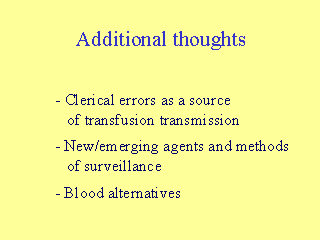| front |1 |2 |3 |4 |5 |6 |7 |8 |9 |10 |11 |12 |13 |14 |15 |16 |17 |18 |19 |review |
 |
- Clerical errors also contribute to transfusion transmission
of agents. These types of errors include release of unsuitable units of blood; accidental
transfusion of autologous blood to another recipient (autologous blood may have positive
infectious disease markers); errors in testing, etc. - Surveillance for new/emerging agents is a major project for the Blood Banking industry. Because many of these agents have similar risk profiles, the donor history questions currently in use help to eliminate these donors from donating. In addition, donor/recipient serum repositories are being developed to have quick access to material to test for transfusion transmission, should a new agent be identified. - Alternatives to blood transfusion are being investigated, including artificial oxygen carriers. |